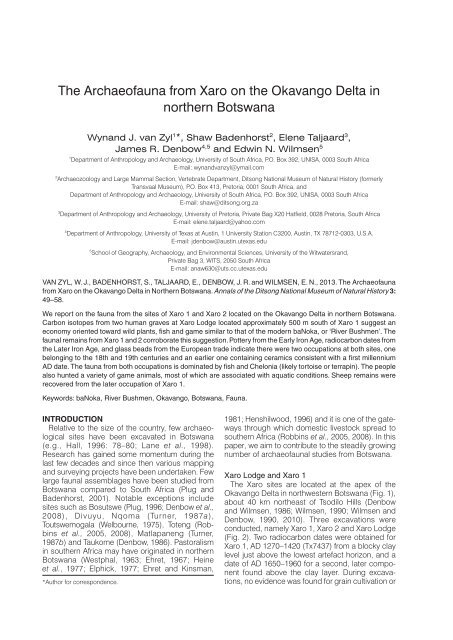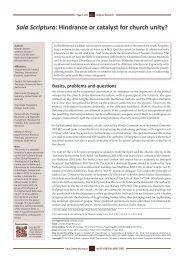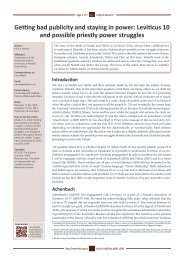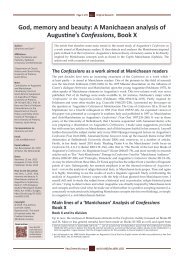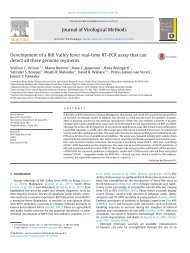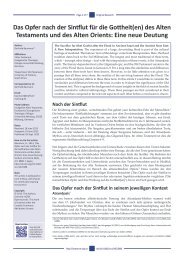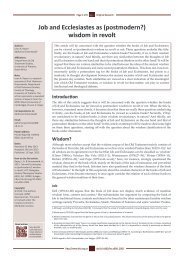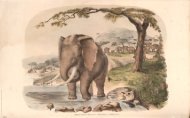View/Open - University of Pretoria
View/Open - University of Pretoria
View/Open - University of Pretoria
You also want an ePaper? Increase the reach of your titles
YUMPU automatically turns print PDFs into web optimized ePapers that Google loves.
The Archae<strong>of</strong>auna from Xaro on the Okavango Delta in<br />
northern Botswana<br />
Wynand J. van Zyl 1 *, Shaw Badenhorst 2 , Elene Taljaard 3 ,<br />
James R. Denbow 4,5 and Edwin N. Wilmsen 5<br />
1 Department <strong>of</strong> Anthropology and Archaeology, <strong>University</strong> <strong>of</strong> South Africa, P.O. Box 392, UNISA, 0003 South Africa<br />
E-mail: wynandvanzyl@ymail.com<br />
2 Archaeozoology and Large Mammal Section, Vertebrate Department, Ditsong National Museum <strong>of</strong> Natural History (formerly<br />
Transvaal Museum), P.O. Box 413, <strong>Pretoria</strong>, 0001 South Africa, and<br />
Department <strong>of</strong> Anthropology and Archaeology, <strong>University</strong> <strong>of</strong> South Africa, P.O. Box 392, UNISA, 0003 South Africa<br />
E-mail: shaw@ditsong.org.za<br />
3 Department <strong>of</strong> Anthropology and Archaeology, <strong>University</strong> <strong>of</strong> <strong>Pretoria</strong>, Private Bag X20 Hatfield, 0028 <strong>Pretoria</strong>, South Africa<br />
E-mail: elene.taljaard@yahoo.com<br />
4 Department <strong>of</strong> Anthropology, <strong>University</strong> <strong>of</strong> Texas at Austin, 1 <strong>University</strong> Station C3200, Austin, TX 78712-0303, U.S.A.<br />
E-mail: jdenbow@austin.utexas.edu<br />
5 School <strong>of</strong> Geography, Archaeology, and Environmental Sciences, <strong>University</strong> <strong>of</strong> the Witwatersrand,<br />
Private Bag 3, WITS, 2050 South Africa<br />
E-mail: anaw630@uts.cc.utexas.edu<br />
VAN ZYL, W. J., BADENHORST, S., TALJAARD, E., DENBOW, J. R. and WILMSEN, E. N., 2013. The Archae<strong>of</strong>auna<br />
from Xaro on the Okavango Delta in Northern Botswana. Annals <strong>of</strong> the Ditsong National Museum <strong>of</strong> Natural History 3:<br />
49–58.<br />
We report on the fauna from the sites <strong>of</strong> Xaro 1 and Xaro 2 located on the Okavango Delta in northern Botswana.<br />
Carbon isotopes from two human graves at Xaro Lodge located approximately 500 m south <strong>of</strong> Xaro 1 suggest an<br />
economy oriented toward wild plants, fish and game similar to that <strong>of</strong> the modern baNoka, or ‘River Bushmen’. The<br />
faunal remains from Xaro 1 and 2 corroborate this suggestion.Pottery from the Early Iron Age, radiocarbon dates from<br />
the Later Iron Age, and glass beads from the European trade indicate there were two occupations at both sites, one<br />
belonging to the 18th and 19th centuries and an earlier one containing ceramics consistent with a first millennium<br />
AD date. The fauna from both occupations is dominated by fish and Chelonia (likely tortoise or terrapin). The people<br />
also hunted a variety <strong>of</strong> game animals, most <strong>of</strong> which are associated with aquatic conditions. Sheep remains were<br />
recovered from the later occupation <strong>of</strong> Xaro 1.<br />
Keywords: baNoka, River Bushmen, Okavango, Botswana, Fauna.<br />
INTRODUCTION<br />
Relative to the size <strong>of</strong> the country, few archaeological<br />
sites have been excavated in Botswana<br />
(e.g., Hall, 1996: 78–80; Lane et al., 1998).<br />
Research has gained some momentum during the<br />
last few decades and since then various mapping<br />
and surveying projects have been undertaken. Few<br />
large faunal assemblages have been studied from<br />
Botswana compared to South Africa (Plug and<br />
Badenhorst, 2001). Notable exceptions include<br />
sites such as Bosutswe (Plug, 1996; Denbow et al.,<br />
2008), Divuyu, Nqoma (Turner, 1987a),<br />
Toutswemogala (Welbourne, 1975), Toteng (Robbins<br />
et al., 2005, 2008), Matlapaneng (Turner,<br />
1987b) and Taukome (Denbow, 1986). Pastoralism<br />
in southern Africa may have originated in northern<br />
Botswana (Westphal, 1963; Ehret, 1967; Heine<br />
et al., 1977; Elphick, 1977; Ehret and Kinsman,<br />
*Author for correspondence.<br />
1981; Henshilwood, 1996) and it is one <strong>of</strong> the gateways<br />
through which domestic livestock spread to<br />
southern Africa (Robbins et al., 2005, 2008). In this<br />
paper, we aim to contribute to the steadily growing<br />
number <strong>of</strong> archae<strong>of</strong>aunal studies from Botswana.<br />
Xaro Lodge and Xaro 1<br />
The Xaro sites are located at the apex <strong>of</strong> the<br />
Okavango Delta in northwestern Botswana (Fig. 1),<br />
about 40 km northeast <strong>of</strong> Tsodilo Hills (Denbow<br />
and Wilmsen, 1986; Wilmsen, 1990; Wilmsen and<br />
Denbow, 1990, 2010). Three excavations were<br />
conducted, namely Xaro 1, Xaro 2 and Xaro Lodge<br />
(Fig. 2). Two radiocarbon dates were obtained for<br />
Xaro 1, AD 1270–1420 (Tx7437) from a blocky clay<br />
level just above the lowest artefact horizon, and a<br />
date <strong>of</strong> AD 1650–1960 for a second, later component<br />
found above the clay layer. During excavations,<br />
no evidence was found for grain cultivation or
50 ANNALS OF THE DITSONG NATIONAL MUSEUM OF NATURAL HISTORY, VOLUME 3, 2013<br />
Fig. 1<br />
Location <strong>of</strong> Xaro in Botswana.<br />
metallurgy (Denbow and Wilmsen, 1986), which<br />
may have suggested occupation by farmers. However,<br />
ceramics found link the site with a western variant<br />
<strong>of</strong> the Early Iron Age extending northward into<br />
Angola and possibly northwestern Zambia<br />
(Denbow and Wilmsen, 1986; Denbow, 1990;<br />
Wilmsen and Denbow, 2010; Denbow, 2012). A<br />
handful <strong>of</strong> un-diagnostic stone flakes were recovered<br />
from both components <strong>of</strong> the site.<br />
The first Xaro excavations were conducted by one<br />
<strong>of</strong> us (J.R.D.) after a human grave was discovered<br />
during construction work at Xaro Lodge. The grave<br />
was found about 1 m below the modern ground<br />
surface in a sandy soil deposit, some 50 m from the<br />
edge <strong>of</strong> the water. The body was found in a horizontal,<br />
flexed position. A Divuyu potsherd dating from the<br />
Early Iron Age was found underneath the leg <strong>of</strong> the<br />
individual. The skeleton is that <strong>of</strong> a 50–60-year-old
VAN ZYL ET AL.: ARCHAEOFAUNA FROM XARO ON THE OKAVANGO DELTA 51<br />
Fig. 2<br />
Location <strong>of</strong> sites.<br />
male. The skull shows similarities with both<br />
Khoisan- and Bantu-speaking populations (Mosothwane,<br />
2010). The second skeleton was excavated<br />
by E.N.W. and Phenyo Thebe in 2006. It was located<br />
approximately two metres from a rapidly eroding<br />
river bank and about 60 m northwest <strong>of</strong> the first<br />
skeleton. It was found in a horizontal flexed position,<br />
with the head oriented towards the west. It is a male<br />
aged between 40 and 60 years <strong>of</strong> age at the time <strong>of</strong><br />
death (Mosothwane, 2010). The two adult skeletons<br />
from Xaro Lodge have bone collagen Ç 13 C values<br />
indicating a foraging and fishing diet; this diet is<br />
similar to that <strong>of</strong> the modern baNoka (the so-called<br />
‘River or Water Bushmen’), who still live along the<br />
banks <strong>of</strong> the Okavango Delta (Mosothwane, 2010).<br />
A brief survey in 1986 found ceramics similar to<br />
that from the original Xaro Lodge skeleton at a location<br />
approximately 500 m north <strong>of</strong> the Lodge. Two<br />
units were excavated at that location; at the time,<br />
this was called the Motorboat Site. Imported glass<br />
beads (n = 14) were found dating to the 18th –19th<br />
century AD in the upper 20 cm. The beads most<br />
likely came from European trade on the West Atlantic<br />
coast spreading along existing Iron Age trade<br />
routes (Denbow and Wilmsen, 1986). In 1991 a new<br />
series <strong>of</strong> excavations was carried out at Xaro 1,<br />
based on a grid with a 00.00 point established in the<br />
eroded area 11 m south <strong>of</strong> the original Motorboat<br />
units excavated in 1986 (Fig. 3). First, a series <strong>of</strong><br />
three 1×1msquares was excavated 40 cm west <strong>of</strong><br />
the original units. Another unit was also opened<br />
1 metre north <strong>of</strong> the original test pits. The stratigra-
52 ANNALS OF THE DITSONG NATIONAL MUSEUM OF NATURAL HISTORY, VOLUME 3, 2013<br />
Fig. 3<br />
Excavation plan <strong>of</strong> Xaro 1.<br />
phy <strong>of</strong> these units replicated that found earlier:<br />
0–20 cm: grey-black humus<br />
20–40 cm: brown, blocky clay<br />
40–60 cm: brown sand<br />
As in the first excavation, three glass beads were<br />
recovered in the upper 20 cm along with pottery<br />
decorated with bands <strong>of</strong> crosshatching on the rim<br />
and false relief chevrons at the base <strong>of</strong> the neck.<br />
These materials are likely precursors <strong>of</strong> contemporary<br />
Hambukushu potting traditions. The blocky<br />
brown clay was practically sterile; artefacts being<br />
found again in the sandier levels between 40 and<br />
60 cm below the surface. The material from these<br />
levels is closely related to those uncovered at<br />
Divuyu (Denbow, 2011) and the lower levels <strong>of</strong><br />
Nqoma (Wilmsen, 2011) in the Tsodilo Hills.<br />
With the completion <strong>of</strong> the first four units, and confirmation<br />
<strong>of</strong> the basic stratigraphy observed in 1986,<br />
a 5 × 10 metre grid was laid out over the site. The<br />
only exception to this systematic sampling strategy<br />
are the two units labelled as Lule, which were dug<br />
back from the edge <strong>of</strong> the erosion area at a point<br />
where several large fragments <strong>of</strong> pottery were<br />
observed eroding from the deposit. The cultural<br />
stratigraphy <strong>of</strong> these units replicated that found in<br />
the original excavation in the Motorboat area,<br />
though the blocky clay layer was not observed in the<br />
southernmost line <strong>of</strong> squares.<br />
A radiocarbon date <strong>of</strong> AD 1650–1960 (Tx-7438),<br />
with five intercepts, was obtained from charcoal<br />
recovered between 10 and 20 cm below surface in<br />
Square 3. The 18th–19th century portion <strong>of</strong> this time<br />
range is consistent with the types <strong>of</strong> trade beads<br />
recovered from these levels (Denbow and Wilmsen,<br />
1986). A second radiocarbon date <strong>of</strong> AD 1270–1420<br />
(Tx-7437), with three intercepts, was obtained from<br />
the blocky clay level 30 to 40 cm below surface that<br />
separated the upper and lower components in<br />
Squares 2 and 3. Unfortunately, no charcoal was<br />
preserved that could adequately date the lower, first<br />
occupation below the blocky clay, although ceramics<br />
found were similar to those from the well-dated sites<br />
<strong>of</strong> Divuyu and Nqoma in the Tsodilo Hills. These two<br />
sites date between the 7th and 9th centuries AD.<br />
Apart from ceramics only eight fragments <strong>of</strong> stone,<br />
two with possible use wear, were recovered from<br />
Xaro 1. No metal artefacts were recovered from the<br />
site.<br />
Xaro 2<br />
The Xaro 2 site was discovered along the sandy<br />
track leading to the Lodge. At that time, a fence with
VAN ZYL ET AL.: ARCHAEOFAUNA FROM XARO ON THE OKAVANGO DELTA 53<br />
Fig. 4<br />
Excavation plan <strong>of</strong> Xaro 2.<br />
a metal gate cut across the peninsula approximately<br />
500 m from the Lodge. A datum point was<br />
established 2 m metres west and 10 m south <strong>of</strong> the<br />
gate, and a series <strong>of</strong> test squares was excavated at<br />
20 m intervals (Fig. 4). A west–east series <strong>of</strong> test<br />
squares was also excavated along a line established<br />
at 00.39 s. A final test square was placed<br />
north <strong>of</strong> the fence along the west side <strong>of</strong> the track.<br />
In all <strong>of</strong> the units south <strong>of</strong> the gate the top 30 cm <strong>of</strong><br />
deposit were composed <strong>of</strong> very loose, uncompacted,<br />
grey sand. Below 30 cm, the soil was<br />
damper and more compact. While no natural stratigraphy<br />
was observed, the artefact distributions<br />
indicate there are two artefact horizons at the site,<br />
the first occurring between 10 and 20 cm below<br />
surface, where artefacts similar to the upper component<br />
at Xaro 1 were recovered. A fragment <strong>of</strong> a<br />
locally made tobacco pipe was associated with<br />
these remains and suggests a 19th century date.<br />
The second horizon begins 50 cm below surface,<br />
where an increase in the number <strong>of</strong> ceramics, all<br />
charcoal-tempered, was found. The few decorated<br />
vessels recovered were stylistically similar to those<br />
recovered from the lower, earlier component at<br />
Xaro 1, and at Divuyu. In the 01e.60s unit, five chert<br />
flakes, one chert core, and one fragment <strong>of</strong><br />
micaceous quartzite or schist were recovered from<br />
30–80 cm below surface, along with charcoaltempered<br />
ceramics. One iron bead and two interconnected<br />
links <strong>of</strong> iron chain were recovered<br />
between 70 and 90 cm below surface in association<br />
with the Divuyu-style ceramics. A single calibrated<br />
date <strong>of</strong> AD 1180–1390 (Tx-7436) was received for<br />
scattered charcoal fragments collected between 90<br />
and 100 cm below surface in squares 38–39s, 1–5e.<br />
This date appears to be contaminated and should<br />
not be considered an accurate date for the lower,<br />
Divuyu component.<br />
METHODOLOGY<br />
The faunal samples from Xaro 1 and 2 were<br />
analysed separately per square and layer, and combined<br />
for this paper because the samples were too<br />
small to reach meaningful conclusions if considered<br />
per individual square and layer. The samples<br />
were analysed at the Ditsong National Museum <strong>of</strong><br />
Natural History (formerly Transvaal Museum)<br />
in <strong>Pretoria</strong>. The analytical method used is that
54 ANNALS OF THE DITSONG NATIONAL MUSEUM OF NATURAL HISTORY, VOLUME 3, 2013<br />
Table 1<br />
Identified and unidentified specimens from Xaro.<br />
Site Identified specimens Unidentified specimens Total % Identified<br />
Xaro 1 780 885 1665 47<br />
Xaro 2 99 375 474 21<br />
Total 879 1260 2139 41<br />
suggested by Driver (2005). According to this<br />
method, any specimen is considered ‘identifiable’<br />
once the element (e.g., humerus, radius, femur)<br />
could be determined. Bovid size classes follow<br />
Brain (1974). The order <strong>of</strong> the mammals follows<br />
Meester et al. (1986), and the nomenclature Skinner<br />
and Chimimba (2005). The measurements are<br />
those suggested by Von den Driesch (1976). The<br />
Number <strong>of</strong> Identified Specimens (NISP) was used to<br />
quantify the fauna (Grayson, 1984; Reitz and Wing,<br />
1999). Skeletal part representation for Bovidae was<br />
not calculated, due to the relatively small sample<br />
size.<br />
RESULTS<br />
A total <strong>of</strong> 2139 faunal specimens was analysed<br />
from the two sites, <strong>of</strong> which 780 (47%) were identified<br />
from Xaro 1, and 99 from Xaro 2 (21%) (Table 1).<br />
Most are from Xaro 1, totalling 1665 specimens. The<br />
percentage identified specimens is higher at Xaro 1<br />
than at Xaro 2. This does not necessarily suggest<br />
that fragmentation was higher at Xaro 2, but rather<br />
that the presence <strong>of</strong> large numbers <strong>of</strong> fish and shells<br />
from the order Chelonia (likely tortoise or terrapin)<br />
increased the percentage identified specimens at<br />
Xaro 1. Few remains were present in the deeper<br />
levels <strong>of</strong> both Xaro 1 and 2.<br />
The assemblage from Xaro 1 and 2 consists <strong>of</strong><br />
mammals, birds, fish, reptiles and molluscs<br />
(Table 2). Carnivores identified include (possible)<br />
dog and spotted-necked otter. Plains zebra, (possibly)<br />
hippopotamus, sheep, (possibly) sheep/goat,<br />
sitatunga and lechwe were also present. Moreover,<br />
a Galliformes bird, Chelonia (likely tortoise or terrapin),<br />
(possibly) Nile monitor, catfish, freshwater<br />
mussels and the giant African land snail were also<br />
identified from the assemblages. There is variation<br />
between Xaro 1 and 2, but this may be due to sample<br />
size, and not human predation. The two most<br />
common taxa in both samples are fish and<br />
Chelonia. The Chelonia are mostly represented by<br />
shell (both plastron and carapace) fragments.<br />
During analysis, taphonomic modifications were<br />
noted (Table 3). A total <strong>of</strong> 207 specimens was burnt.<br />
Black was the most common colour <strong>of</strong> burning. A<br />
further 16 specimens had cut marks. Xaro 1 yielded<br />
a possible bone tool. The specimen was from<br />
Unit 4, layer 10–20. It was a metacarpal shaft <strong>of</strong> a<br />
Bov II/III individual, and the outer cortex was<br />
smooth.<br />
Only two specimens were complete enough to be<br />
measured. Both are from lechwe, and were found at<br />
Xaro 1 in Unit 2, layer 10–20. Both specimens are<br />
proximal phalanges (Table 4). The two phalanges<br />
may be from the same individual.<br />
DISCUSSION AND CONCLUSION<br />
The faunal analysis from the Xaro sites adds to the<br />
growing knowledge <strong>of</strong> subsistence practices in<br />
northern Botswana during the last two millennia.<br />
<strong>Open</strong>-air sites in the region cannot be grouped into<br />
convenient categories such as farmer, pastoral or<br />
hunter-gatherer (cf. Sadr, 1997). For example,<br />
Toteng yielded domestic livestock, pottery and<br />
lithics (Robbins et al., 2008) whilst at Xaro 1 evidence<br />
<strong>of</strong> pottery was present from the early component<br />
and sheep from more recent times. Isotopes from<br />
the two undated human skeletons excavated at the<br />
Xaro Lodge indicate that people subsisted on inter<br />
alia fish and collected plants. This subsistence<br />
pattern is very similar to that <strong>of</strong> the modern-day<br />
baNoka (Mosothwane, 2010).<br />
The wild mammals in the samples – spotted-necked<br />
otter, plains zebra, hippopotamus, sitatunga and<br />
lechwe – are still present in the area (Plug and<br />
Badenhorst, 2001; Skinner and Chimimba, 2005).<br />
Sheep have been present in northern Botswana<br />
for more than 2000 years (Robbins et al., 2005,<br />
2008). Early sites in southern Africa with sheep<br />
remains are <strong>of</strong>ten found in association with Later<br />
Stone Age communities (Plug and Badenhorst,<br />
2001: 147). From the northern parts <strong>of</strong> southern<br />
Africa, sheep then spread further south to South<br />
Africa (e.g., Henshilwood, 1996). No sheep remains<br />
were associated with the early components at<br />
Xaro 1 and Xaro 2, though they were recovered from<br />
the upper component <strong>of</strong> Xaro 1, which dates to the<br />
18th–19th century. The sheep could have been<br />
acquired from farmers and herders in the area.<br />
There are many diseases that affect domestic<br />
animals. One <strong>of</strong> these, nagana, is transmitted by<br />
tsetse flies (Mönnig and Veldman, 1976). Large<br />
areas can become completely unsuitable for herding<br />
(e.g., Le Roux, 1977). Tsetse fly belts are known
VAN ZYL ET AL.: ARCHAEOFAUNA FROM XARO ON THE OKAVANGO DELTA 55<br />
Table 2<br />
Taxa present at Xaro1 and Xaro2 (NISP).<br />
Taxa Common name Xaro 1 Xaro 2 Total<br />
0–30 cm > 30 cm 0–30 cm >30 cm<br />
cf. Canis familiaris Possibly dog 3 3<br />
Lutra maculicollis Spotted-necked otter 3 3<br />
Carnivore small Small carnivore 1 1<br />
Equus quagga Plains zebra 8 8<br />
cf. Hippopotamus Possibly hippopotamus 1 1<br />
amphibius<br />
Ovis aries Sheep 2 2<br />
cf. Ovis/Capra Possibly sheep/goat 1 1<br />
Tragelaphus spekii Sitatunga 1 1<br />
Kobus leche Lechwe 3 2 5<br />
Bov I Small bovid 1 1<br />
Bov II Medium bovid 10 1 11<br />
Bov II non-domestic Medium bovid non-domestic 1 1<br />
Bov II/III Medium–large bovid 9 1 10<br />
Bov II/III non-domestic Medium–large non-domestic bovid 1 1<br />
Bov III Large bovid 6 1 1 11 19<br />
Bov III non-domestic Large bovid non-domestic 5 5 10<br />
Mammal medium Medium mammal 11 2 13<br />
Mammal medium–large Medium–large mammal 4 4<br />
Mammal large Large mammal 4 2 6<br />
Galliformes Chicken/pheasant/guinea fowl 2 1 3<br />
Bird small Small bird 1 1<br />
Bird small–medium Small–medium bird 1 1<br />
Bird medium Medium bird 1 1<br />
cf. Pelusios rhodesianus / Side-necked terrapin 1 1<br />
bechuanicus<br />
Chelonia Tortoise/terrapin 84 2 52 1 139<br />
Varanus cf. niloticus Possibly Nile monitor 1 1<br />
Varanus sp. Monitor 8 8<br />
cf. Reptilia Possibly reptile 1 1<br />
Clarias sp. Catfish 3 1 4<br />
Clarias / Synodontis Catfish 220 17 19 256<br />
Fish small Small fish 22 22<br />
Fish medium Medium fish 199 7 1 207<br />
Fish medium–large Medium–large fish 7 7<br />
Unionidae Freshwater mussel 39 39<br />
Achatina sp. Giant African land snail 10 22 32<br />
Terrestrial gastropod Land snail 36 11 47<br />
Total 713 67 83 16 879<br />
to decrease and expand again very rapidly (e.g.,<br />
Punt, 1958). For example, in recent times there was<br />
a nagana outbreak in a previously disease-free<br />
region around Lake Ngami, located south <strong>of</strong> the<br />
Okavango Delta (e.g., Rey, 1932). While sheep and<br />
cattle are heavily affected by nagana, goats are<br />
more resistant (Badenhorst, 2002, 2006).<br />
Dogs were present at Early Iron Age sites in southern<br />
Africa. Some <strong>of</strong> the earliest evidence is from<br />
Table 3<br />
Taphonomy from Xaro (number <strong>of</strong> specimens).<br />
Modification Xaro 1 Xaro 2 Total<br />
Localized burning 4 4<br />
Burnt black 33 103 136<br />
Burnt white, grey or blue 55 12 67<br />
Cut marks 14 2 16<br />
Diamant in the Limpopo Province, dating to<br />
the 6th century AD (Plug, 2000). In Botswana,<br />
Bosutswe also yielded dog remains (Plug, 1996).<br />
Dog remains are not common in archaeological<br />
deposits. Most would have died from natural<br />
causes or during hunting activities (Plug and<br />
Badenhorst, 2001: 37). The (possible) dog from<br />
Xaro could have been used for protection and<br />
hunting.<br />
Table 4<br />
Measurements (mm) from Xaro 2.<br />
Taxa Element Measurement (mm)<br />
Kobus leche 1st Phalange GL: 51.04, Bp: 13.66,<br />
Bd: 12.28, SD: 11.8<br />
Kobus leche 1st Phalange GL: 51.45, Bp: 14.21,<br />
Bd: 12.8, SD: 12.37
56 ANNALS OF THE DITSONG NATIONAL MUSEUM OF NATURAL HISTORY, VOLUME 3, 2013<br />
Hippopotami are dangerous animals (Skinner<br />
and Chimimba, 2005) and were <strong>of</strong>ten killed in<br />
pitfall-traps (Hall, 1977), or in the Okavango by the<br />
Khoisan and Bantu-speakers using iron-tipped<br />
harpoons in more recent times (Schapera, 1930:<br />
136; Andersson, 1856). The use <strong>of</strong> pitfall-traps is<br />
seemingly an old custom in southern Africa, with the<br />
earliest evidence dating from the Middle Stone Age<br />
(Milo, 1998). It appears feasible that the (possible)<br />
hippopotamus from Xaro 1 was hunted in a similar<br />
fashion. However, the alternative explanation<br />
cannot be excluded that meat was scavenged from<br />
dying hippopotami. A buried skull <strong>of</strong> a hippopotamus<br />
was uncovered at Toteng 1. Although the role <strong>of</strong><br />
hippopotami varies considerably in Africa, in the<br />
Okavango Delta <strong>of</strong> Botswana, the traditional manner<br />
for Wayeyi (a Bantu-speaking group) boys to<br />
become men involve killing a hippo from papyrus<br />
rafts using spears. The death <strong>of</strong> a hippopotamus<br />
was believed to ensure good flooding <strong>of</strong> the Delta<br />
(Robbins et al., 2008: 137). Hippopotami have also<br />
been associated with rain-making rituals (e.g.,<br />
Deacon, 1988: 133–134).<br />
Aquatic food sources were exploited at Xaro. This<br />
is evident from the otter, (possible) hippopotamus,<br />
lechwe, sitatunga, terrapin, (possible) water monitor,<br />
freshwater mussels and fish remains. The African<br />
sharp-tooth catfish is the best-known member <strong>of</strong><br />
the genus Clarias in South Africa, and is common in<br />
many river systems <strong>of</strong> Africa. It is a large fish that<br />
can grow up to two metres in length, with the skull<br />
measuring up to 60 cm across. The meat is red, <strong>of</strong><br />
good quality, has few bones, and is rich in oil<br />
(Brandt, 1982: 14–15). At least two families <strong>of</strong> catfish<br />
are present in the samples, and they were distinguished<br />
based on the morphology <strong>of</strong> the dorsal<br />
fins. Among the contemporary peoples <strong>of</strong> the<br />
Okavango, fishing is as important as hunting. Common<br />
methods include the use <strong>of</strong> funnel-shaped<br />
traps <strong>of</strong> closely woven reeds, about three feet long<br />
(c. 91 cm) and 18 inches (c. 46 cm) to two feet<br />
(c. 61 cm) wide, narrowing towards the mouth. The<br />
traps are set in shallow water. Another technique is<br />
to use spears. Sometimes small stone dams are<br />
built from each bank that turn out into the river in a<br />
slanting direction, leaving a narrow opening in<br />
which a reed trap is placed. Yet another method is to<br />
built reed fences or stone dams across the beds <strong>of</strong><br />
dry courses <strong>of</strong> rivers that overflow from time to<br />
time. After a flood, as the water begins to retreat, fish<br />
are trapped and caught. The poisoning <strong>of</strong> fish in<br />
small pools was a common practice, using the<br />
poisonous milky sap from the spurge or milkbush<br />
(Euphorbia tirucalli) (Tlou, 1972: 153; Mmopelwa<br />
et al., 2005: 11). Wild foods including wild figs and<br />
biltong are important items traded by Okavango<br />
peoples from the northern Delta to Maun during the<br />
rainy season (Denbow, personal observation).<br />
Excavations at White Paintings Rock Shelter in the<br />
Tsodilo Hills, 40 km to the west <strong>of</strong> the Okavango<br />
River yielded 15 barbed bone points associated<br />
with fishing spears. These date from the Late Pleistocene<br />
to the Iron Age, which suggests an exploitation<br />
<strong>of</strong> aquatic resources for a period <strong>of</strong> 25 000 years. As<br />
with the Xaro sites, fish and wetland antelope fauna<br />
were also well represented in the deposits <strong>of</strong> White<br />
Paintings Rock Shelter (Robbins et al., 1994: 257,<br />
260, 262).<br />
The Chelonian remains from the Xaro sites may be<br />
either land tortoises or terrapins. Owing to the locality<br />
<strong>of</strong> the sites, it is possible that most <strong>of</strong> the indeterminate<br />
Chelonian specimens are from terrapins,<br />
although the high level <strong>of</strong> fragmentation makes it<br />
impossible to be certain. Tortoises are usually<br />
baked in the shell, and can easily supply a meal for a<br />
family <strong>of</strong> up to four people (Yellen and Lee, 1976:<br />
41). It is likely that terrapins were treated in the very<br />
same manner. A few Chelonian shells were only<br />
burnt on the outer surface, which suggests that the<br />
animals were cooked in the shell (cf. Plug, 1978;<br />
FitzSimons, 1935).<br />
Only the water monitor is (possibly) represented in<br />
the Xaro 1 sample, although the mountain monitor<br />
could also be present. According to Branch (1988:<br />
172–174) both the mountain and water monitor are<br />
indigenous to northern Botswana and both species<br />
are edible, whilst the fat is ‘…used for tribal medicine.’<br />
The people from Xaro may not have necessarily<br />
used the fat <strong>of</strong> monitors for this purpose, but could<br />
simply have consumed them.<br />
A variety <strong>of</strong> terrestrial molluscs are found in<br />
Botswana (e.g., Van Bruggen, 1963, 1966). The giant<br />
African land snail could have been exploited as a<br />
source <strong>of</strong> protein, as they are edible (Mead, 1961).<br />
Their shells are also used to manufacture beads.<br />
However, the presence <strong>of</strong> these snails may also be<br />
due to later intrusions into the sites (Plug, 1990). The<br />
inhabitants collected the freshwater mussels as a<br />
source <strong>of</strong> food (cf. Plug, 1988; Badenhorst, 2005).<br />
Appleton (1996: 8) comments that these large<br />
mussels have an average nutritional value <strong>of</strong><br />
100–575 kilojoules per individual, and when eaten<br />
in quantities, they would certainly be nutritious.<br />
Although mussel shells were <strong>of</strong>ten used as tools,<br />
such as implements for smoothing clay objects, or<br />
worked as beads, no evidence <strong>of</strong> modification was<br />
found to be present at Xaro.<br />
Taphonomic modifications were noted in that a<br />
single bone fragment has a polished appearance,<br />
which can be attributed either to frequent handling<br />
as an implement, or trampling. Bones deposited in<br />
a s<strong>of</strong>t matrix could develop a polished texture as a<br />
result <strong>of</strong> trampling (Reitz and Wing, 1999: 137). Burnt<br />
bone found is a consequence <strong>of</strong> exposure to a heat
VAN ZYL ET AL.: ARCHAEOFAUNA FROM XARO ON THE OKAVANGO DELTA 57<br />
source (coals or fire), resulting in colouring which<br />
could range from black to shades <strong>of</strong> grey to white –<br />
the latter indicating exposure to a more intense or<br />
prolonged heat source (Reitz and Wing, 1999: 133).<br />
Localized burning is evident in a dual coloured bone<br />
such as black (charred) and brown (meat covered)<br />
as a result <strong>of</strong> roasting (Driver, 2005). Grey and white<br />
coloured bones are mostly associated with disposal<br />
in fire pits (Reitz and Wing, 1999: 133). Most <strong>of</strong> the<br />
fish bones from Xaro 1 lack evidence <strong>of</strong> burning,<br />
which may be attributed to the possibility that fish<br />
were roasted or boiled whole over a relatively low<br />
heat.<br />
Not many faunal assemblages have been studied<br />
from northern Botswana (Plug and Badenhorst,<br />
2001; Lane et al., 1998). However, livestock herding<br />
was established in the area by the advent <strong>of</strong> the<br />
Early Iron Age about two millennia ago (Robbins et<br />
al., 2005, 2008; Turner, 1987a,b). The fauna from<br />
Xaro is consistent with the local environment, and<br />
adds to the growing number <strong>of</strong> faunal studies from<br />
the region.<br />
REFERENCES<br />
ANDERSSON, C. J., 1856. Lake Ngami; or explorations and<br />
discoveries during four years’ wandering in the wilds <strong>of</strong><br />
south western Africa. (reproduced 1987). Struik, Cape<br />
Town.<br />
APPLETON, C. C., 1996. Freshwater molluscs <strong>of</strong> southern<br />
Africa. <strong>University</strong> <strong>of</strong> Natal Press, Pietermaritzburg.<br />
BADENHORST, S., 2002. The ethnography, archaeology,<br />
rock art and history <strong>of</strong> goats (Capra hircus) in southern<br />
Africa: an overview. Anthropology Southern Africa<br />
25(3&4): 96–103.<br />
BADENHORST, S., 2005.Where are the pearls? Freshwater<br />
and marine pearls and their possible role in South African<br />
societies in the past. Annals <strong>of</strong> the Transvaal Museum<br />
42: 1–4.<br />
BADENHORST, S., 2006. Goats (Capra hircus), the Khoekhoen<br />
and pastoralism: current evidence from southern<br />
Africa. African Archaeological Review 23: 45–53.<br />
BRAIN, C. K., 1974. Some suggested procedures in the<br />
analysis <strong>of</strong> bone accumulations from southern African<br />
Quaternary sites. Annals <strong>of</strong> the Transvaal Museum 29:<br />
1–8.<br />
BRANCH, B., 1988. Field guide to the snakes and other<br />
reptiles <strong>of</strong> southern Africa. Struik, Cape Town.<br />
BRANDT, F. de W., 1982. Clarias – the hyena <strong>of</strong> our rivers<br />
and dams.Fauna & Flora Transvaal Nature Conservation<br />
Division 39: 14–15.<br />
DEACON, J., 1988. The power <strong>of</strong> a place in understanding<br />
southern San rock engravings.World Archaeology 20(1):<br />
129–140.<br />
DENBOW, J. R., 1986. A new look at the later prehistory <strong>of</strong><br />
the Kalahari. Journal <strong>of</strong> African History 27: 3–29.<br />
DENBOW, J. R., 1990. Congo to Kalahari: data and hypotheses<br />
about the political economy <strong>of</strong> the Western Stream <strong>of</strong><br />
the Early Iron Age. The African Archaeological Review 8:<br />
139–175.<br />
DENBOW, J. R., 2011. Excavations at Divuyu, Tsodilo Hills.<br />
Botswana Notes and Records 43: 76–94.<br />
DENBOW, J. R., 2012. Pride, prejudice, plunder and preservation:<br />
archaeology and the re-envisioning <strong>of</strong> ethnogenesis<br />
on the Loango Coast <strong>of</strong> the Republic <strong>of</strong> Congo.<br />
Antiquity 86: 383–408.<br />
DENBOW, J. R., SMITH, J., NDOBOCHANI, N. M.,<br />
ATWOOD, K. and MILLER, D., 2008. Archaeological<br />
excavations at Bosutswe, Botswana: cultural chronology,<br />
paleo-ecology and economy. Journal <strong>of</strong> Archaeological<br />
Science 35: 459–480.<br />
DENBOW, J. R. and WILMSEN, E. N., 1986. Advent and<br />
course <strong>of</strong> pastoralism in the Kalahari. Science 234:<br />
1509–1515.<br />
DRIVER, J. C., 2005. Manual for description <strong>of</strong> vertebrate<br />
remains. Unpublished manual. Crow Canyon Archaeological<br />
Center, Cortez.<br />
EHRET, C., 1967. Cattle-keeping and milking in eastern and<br />
southern African history: the linguistic evidence. The<br />
Journal <strong>of</strong> African History 8: 1–17.<br />
EHRET, C. and KINSMAN, M., 1981. Shona dialect classification<br />
and its implications for Iron Age history in southern<br />
Africa. International Journal <strong>of</strong> African Historical Studies<br />
14(3): 401–443.<br />
ELPHICK, R., 1977. Kraal and castle: Khoikhoi and the<br />
founding <strong>of</strong> White South Africa. Yale <strong>University</strong> Press,<br />
New Haven.<br />
FITZSIMONS, V., 1935. Scientific results <strong>of</strong> the Vernay-Lang<br />
Kalahari expedition, March to September 1930 (Reptilia<br />
and Amphibia). Annals <strong>of</strong> the Transvaal Museum 16:<br />
295–397.<br />
GRAYSON, D.K., 1984.Quantitative zooarchaeology: topics<br />
in the analysis <strong>of</strong> archaeological faunas. Academic<br />
Press, Orlando.<br />
HALL, M., 1977.Shakan pitfall traps:hunting technique in the<br />
Zulu Kingdom.Annals <strong>of</strong> the Natal Museum 23(1):1–12.<br />
HALL, M., 1996. Archaeology Africa. David Philip, Cape<br />
Town.<br />
HEINE, B., HOFF, H. and VOSSEN, R., 1977. Neuere<br />
Ergebnisse zur Territorialgeschichte der Bantu. In:<br />
MÖHLIG, W. J. G., ROTTLAND, F. and HEINE, B., eds.,<br />
Zur Sprachgeschichte und Ethnohistorie in Afrika, pp.<br />
57–72. Dietrich Reimer Verlag, Berlin.<br />
HENSHILWOOD, C., 1996. A revised chronology for<br />
pastoralism in southernmost Africa: new evidence <strong>of</strong><br />
sheep at c. 2000 b.p. from Blombos Cave, South Africa.<br />
Antiquity 70: 945–949.<br />
LANE, P., REID, A. and SEGOBYE, A., eds, 1998. Ditswa<br />
Mmung: the archaeology <strong>of</strong> Botswana. Pula Press and<br />
The Botswana Society, Gaborone.<br />
LE ROUX, T. H., 1977. Die dagboek van Louis Trigardt. J. L.<br />
van Schaik, <strong>Pretoria</strong>.<br />
MEAD, A. R., 1961. The giant African land snail: a problem in<br />
malacology. <strong>University</strong> <strong>of</strong> Chicago, Chicago.<br />
MEESTER, J. A. J., RAUTENBACH, I. L., DIPPENAAR, N. J.<br />
and BAKER, C. M., 1986. Classification <strong>of</strong> southern<br />
African mammals. Transvaal Museum Monograph No. 5.<br />
Transvaal Museum, <strong>Pretoria</strong>.<br />
MILO, R.G., 1998.Evidence for hominid predation at Klasies<br />
River Mouth, South Africa, and its implications for the<br />
behaviour <strong>of</strong> early modern humans. Journal <strong>of</strong> Archaeological<br />
Science 25: 99–133.<br />
MMOPELWA, G., RALETSATSI, S. and MOSEPELE, K.,<br />
2005. Cost benefit analysis <strong>of</strong> commercial fishing in<br />
Shakawe, Ngamiland. Special edition on human interactions<br />
and natural resource dynamics in the Okavango<br />
Delta and Ngamiland. Botswana Notes and Records 37:<br />
11–21.<br />
MOSOTHWANE, M. N., 2010. Foragers among farmers in<br />
the Early Iron Age <strong>of</strong> Botswana: dietary evidence from
58 ANNALS OF THE DITSONG NATIONAL MUSEUM OF NATURAL HISTORY, VOLUME 3, 2013<br />
stable isotopes. Ph.D. dissertation, <strong>University</strong> <strong>of</strong> the<br />
Witwatersrand, Johannesburg.<br />
MÖNNIG, H. O. and VELDMAN, F. J., 1976. Handbook on<br />
stock diseases. Tafelberg, Cape Town.<br />
PLUG, I., 1978. Die Latere Steentydperk van die Boesmanrotsskuiling<br />
in Oos-Transvaal. M.A. thesis, <strong>University</strong> <strong>of</strong><br />
<strong>Pretoria</strong>, <strong>Pretoria</strong>.<br />
PLUG, I., 1988. Hunters and herders: an archaeozoological<br />
study <strong>of</strong> some prehistoric communities in the Kruger<br />
National Park. D.Phil. dissertation, <strong>University</strong> <strong>of</strong> <strong>Pretoria</strong>,<br />
<strong>Pretoria</strong>.<br />
PLUG, I., 1990. Terrestrial molluscs and archaeological<br />
stratigraphy: a cautionary tale. South African Journal <strong>of</strong><br />
Science 86: 204–205.<br />
PLUG, I., 1996. Seven centuries <strong>of</strong> Iron Age tradition at<br />
Bosutswe, Botswana:a faunal perspective.South African<br />
Journal <strong>of</strong> Science 92: 91–97.<br />
PLUG, I., 2000. Overview <strong>of</strong> the Iron Age fauna from the<br />
Limpopo Valley. In: LESLIE, M.and MAGGS, T., eds, African<br />
naissance: the Limpopo Valley 1000 years ago, pp.<br />
117–126. South African Archaeological Society Goodwin<br />
series 8, Vlaeberg.<br />
PLUG, I. and BADENHORST, S., 2001. The distribution <strong>of</strong><br />
macromammals in southern Africa over the past 30 000<br />
years as reflected in animal remains from archaeological<br />
sites. Transvaal Museum Monograph No. 12. Transvaal<br />
Museum, <strong>Pretoria</strong>.<br />
PUNT, W. H. J., 1958. Die verkenning van die Krugerwildtuin<br />
deur die Hollandse Oos-Indiese Kompanje, 1725.<br />
Koedoe 1: 1–18.<br />
REITZ, E. J. and WING, E. S., 1999. Zooarchaeology. Cambridge<br />
Manuals in Archaeology, Cambridge <strong>University</strong><br />
Press, Cambridge.<br />
REY, C. F., 1932. Ngamiland and the Kalahari. Geographical<br />
Journal 80(4): 281–307.<br />
ROBBINS, L. H., MURPHY, M. L., STEWART, K. M., CAMP-<br />
BELL, A. C. and BROOK, G. A., 1994. Barbed bone<br />
points: paleoenvironment, and the antiquity <strong>of</strong> fish exploitation<br />
in the Kalahari Desert, Botswana. Journal <strong>of</strong> Field<br />
Archaeology 21(2): 257–264.<br />
ROBBINS, L. H., CAMPBELL, A. C., MURPHY, M. L.,<br />
BROOK, G. A., SRIVASTAVA, P. and BADENHORST, S.,<br />
2005. The advent <strong>of</strong> herding in southern Africa: early<br />
AMS dates on domestic livestock from the Kalahari<br />
Desert. Current Anthropology 46(4): 671–677.<br />
ROBBINS, L. H., CAMPBELL, A. C., MURPHY, M. L.,<br />
BROOK, G. A., LIANG, F., SKAGGS, S. A.,<br />
SRIVASTAVA, P., MABUSE, A. A. and BADENHORST,<br />
S., 2008. Recent archaeological and paleoenvironmental<br />
research at Toteng, Botswana: early domesticated<br />
livestock in the Kalahari. Journal <strong>of</strong> African<br />
Archaeology 6(1): 131–149.<br />
SADR, K., 1997. Kalahari archaeology and the Bushmen<br />
debate. Current Anthropology 38(1): 104–112.<br />
SCHAPERA, I., 1930. The Khoisan peoples <strong>of</strong> South Africa.<br />
George Routledge and Sons, London.<br />
SKINNER, J. D. and CHIMIMBA, C. T., 2005. The mammals<br />
<strong>of</strong> the southern African subregion. Cambridge <strong>University</strong><br />
Press, Cambridge.<br />
TLOU, T., 1972. The taming <strong>of</strong> the Okavango swamps – the<br />
utilization <strong>of</strong> a riverine environment ±1750 – ±1800.<br />
Botswana Notes and Records 4: 147–159.<br />
TURNER, G., 1987a.Early Iron Age herders in northwestern<br />
Botswana: the faunal evidence. Botswana Notes and<br />
Records 19: 7–23.<br />
TURNER, G., 1987b. Hunters and herders <strong>of</strong> the Okavango<br />
Delta, northern Botswana.Botswana Notes and Records<br />
19: 25–40.<br />
VAN BRUGGEN, A. C., 1963. Report on the mollusca <strong>of</strong> the<br />
1961 Harvard-Smithsonian-Transvaal Museum Kalahari<br />
expedition.Annals <strong>of</strong> the Transvaal Museum 24:261–270.<br />
VAN BRUGGEN, A. C., 1966. Notes on non-marine molluscs<br />
from Mozambique and Bechuanaland with a checklist <strong>of</strong><br />
Bechuanaland species.Annals <strong>of</strong> the Transvaal Museum<br />
25(6): 99–113.<br />
VON DEN DRIESCH, A., 1976. A guide to the measurements<br />
<strong>of</strong> animal bones from archaeological sites. Peabody<br />
Museum Bulletin 1.Harvard <strong>University</strong>, Cambridge.<br />
WELBOURNE, R.G., 1975.Tautswe Iron Age site: its yield <strong>of</strong><br />
bones. Botswana Notes and Records 7: 1–16.<br />
WESTPHAL, E. O. J., 1963. The linguistic prehistory <strong>of</strong><br />
southern Africa: Bush, Kwadi, Hottentot, and Bantu<br />
linguistic relationships. Africa 33: 237–265.<br />
WILMSEN, E. N., 1990. The real Bushman is the male one:<br />
labour and power in the creation <strong>of</strong> Basarwa ethnicity.<br />
Botswana Notes and Records 22: 21–35.<br />
WILMSEN, E. N., 2011. Nqoma: an abridged review.<br />
Botswana Notes and Records 43: 95–114.<br />
WILMSEN, E.N.and DENBOW, J.R., 1990.Almost outcasts:<br />
paradigmatic history <strong>of</strong> San-speaking peoples and<br />
current attempts at reconstruction.Current Anthropology<br />
31: 489–524.<br />
WILMSEN, E. N. and DENBOW, J. R., 2010. Early villages at<br />
Tsodilo: the introduction <strong>of</strong> livestock, crops and metalworking.<br />
In: ROBBINS, L., CAMPBELL, A. and TAYLOR,<br />
M., eds, Tsodilo Hills: copper bracelet <strong>of</strong> the Kalahari,<br />
pp. 85–93. Michigan State <strong>University</strong> Press, East<br />
Lansing.<br />
YELLEN, J. E. and LEE, R. B., 1976. The Dobe-/Du/da<br />
environment.Background to a hunting and gathering way<br />
<strong>of</strong> life. In: LEE, R. B. and DEVORE, I., eds, Kalahari<br />
hunter-gatherers. Studies <strong>of</strong> the !Kung San and their<br />
neighbors, pp. 28–46. Harvard <strong>University</strong> Press,<br />
Cambridge.


